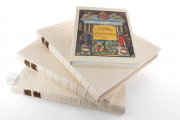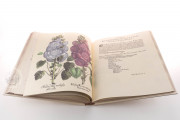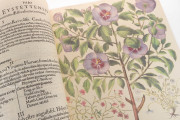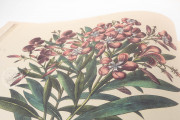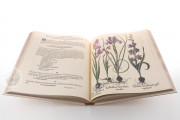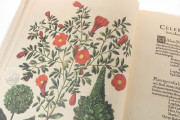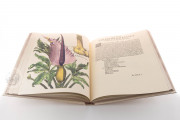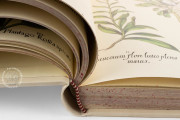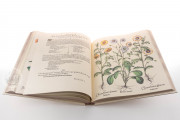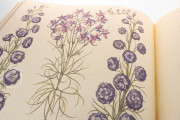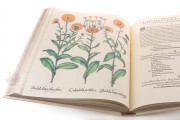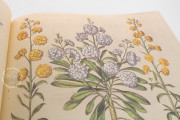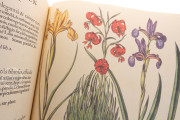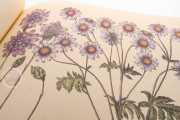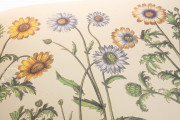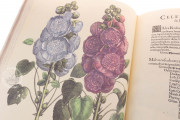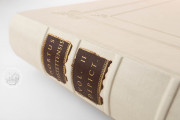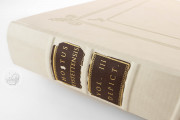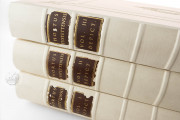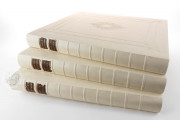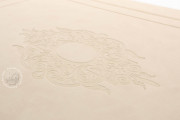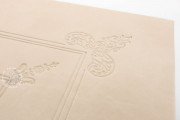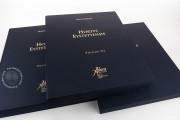The Hortus Eystettensis, published in 1613, is a botanical florilegium created by Basilius Besler, a Nuremberg apothecary and botanist, at the commission of Prince-Bishop Johann Konrad von Gemmingen. It documents the prince-bishop's garden at Willibaldsburg in Eichstätt, featuring 366 copperplate engravings that depict more than 1,000 plant species, organized by season. The Eichstätt copy is of the deluxe edition, with the plates printed on one side of the paper and the backs blank. The paper is of the highest quality, and its life-sized (or nearly life-sized) images were expertly hand-colored, possessing a singular luminosity.
Basilius Besler: Apothecary and Botanical Visionary
Basilius Besler was a distinguished apothecary and botanist from Nuremberg, Germany. His expertise in plants and medicine earned him the prestigious appointment in 1596 as curator of the botanical garden of Johann Konrad von Gemmingen, Prince-Bishop of Eichstätt in Bavaria. This garden was unique: the only significant European botanical collection outside Italy at the time. Situated around the bishop’s hilltop palace, Willibaldsburg, the gardens offered a commanding view of the town below and served as a living laboratory for botanical study and cultivation.
Hortus Eystettensis: The Monumental Botanical Codex
Commissioned by Bishop von Gemmingen, Besler embarked on a monumental project: compiling a comprehensive codex of the plants within the Eichstätt gardens. The endeavor, which took sixteen years to complete, was a collaborative effort involving Besler’s brother and a team of highly skilled German draughtsmen and engravers. The resulting masterpiece, Hortus Eystettensis (Garden at Eichstätt), revolutionized botanical illustration.
Prior to Besler’s work, botanical art predominantly focused on medicinal and culinary herbs, often depicted in a simplistic, utilitarian style. These earlier illustrations were frequently inadequate for plant identification and offered limited aesthetic appeal. Hortus Eystettensis marked a dramatic departure from this tradition, blending scientific precision with artistic sophistication.
Transforming Botanical Illustration
Hortus Eystettensis showcased a wide variety of flora, including garden flowers, herbs, vegetables, and exotic specimens such as castor-oil plants and arum lilies. Besler’s plates were nearly life-sized and rendered with extraordinary detail, capturing both the structure and the subtle beauty of each plant. The layout of the work demonstrated a modern sensibility, combining clarity and visual elegance, while meticulous hand-coloring enhanced the overall effect.
Seasonal Organization and Scientific Insight
One of the defining features of Hortus Eystettensis is its organization according to the seasons. The codex progresses from flowering to fruiting stages, reflecting the natural cycle of plant life. Winter is sparsely represented with just seven plates, while spring bursts into life with 134 plates illustrating 454 species. Summer follows in full abundance with 184 plates depicting 505 plants, and autumn concludes the work with 42 plates and 98 species.
The accompanying Latin descriptions exhibit remarkable foresight, anticipating the binomial nomenclature system that would later define modern taxonomy. Besler’s own portrait adorns the frontispiece, holding a sprig of greenery—believed to be basil—a symbolic nod to his dual role as scientist and gardener.
Legacy of the Hortus Eystettensis
By combining artistic mastery, scientific rigor, and encyclopedic scope, Besler’s Hortus Eystettensis elevated botanical illustration to a new standard. Its influence resonated across Europe, establishing a model for botanical codices and inspiring generations of naturalists and artists alike. Today, it remains an essential reference for historians, botanists, and enthusiasts of horticultural art.
We have 1 facsimile edition of the manuscript "Hortus Eystettensis by Basilius Besler": Hortus Eystettensis facsimile edition, published by Aboca Museum, 2006
Request Info / Price

